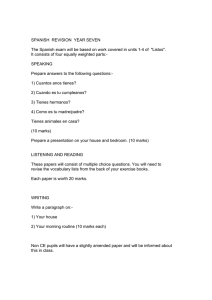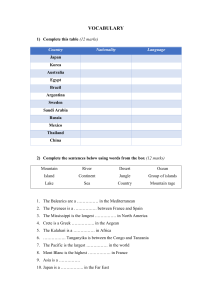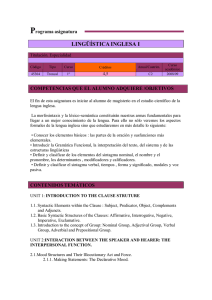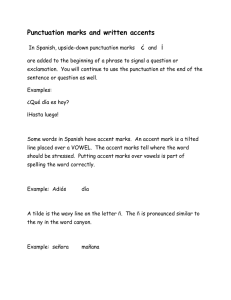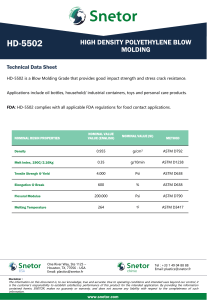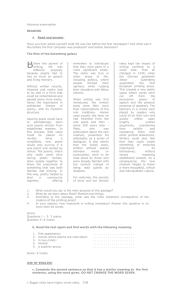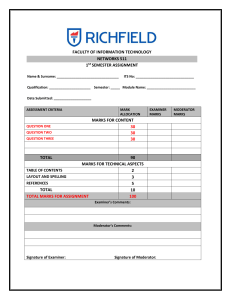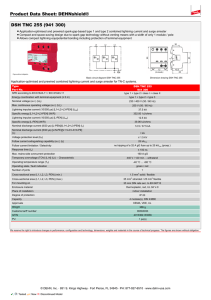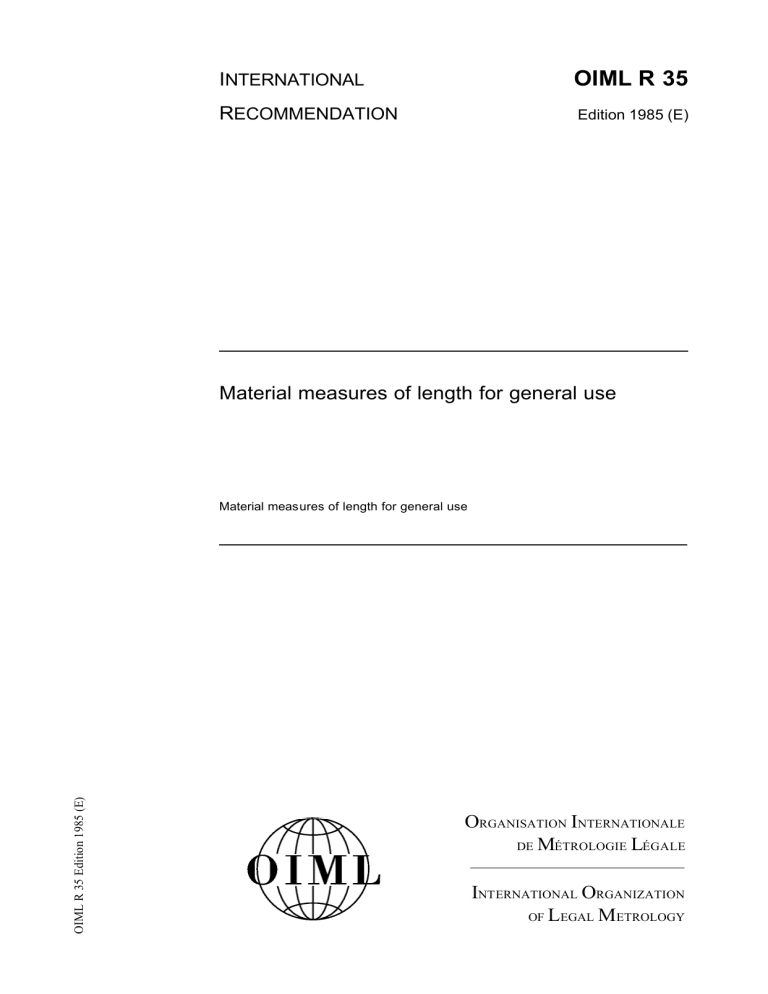
INTERNATIONAL OIML R 35 RECOMMENDATION Edition 1985 (E) Material measures of length for general use OIML R 35 Edition 1985 (E) Material measures of length for general use ORGANISATION INTERNATIONALE DE MÉTROLOGIE LÉGALE INTERNATIONAL ORGANIZATION OF LEGAL METROLOGY Foreword The International Organization of Legal Metrology (OIML) is a worldwide, intergovernmental organization whose primary aim is to harmonize the regulations and metrological controls applied by the national metrological services, or related organizations, of its Member States. Cooperative agreements are established between OIML and certain institutions, such as ISO and IEC, with the objective of avoiding contradictory requirements; consequently, manufacturers and users of measuring instruments, test laboratories, etc. may apply simultaneously OIML publications and those of other institutions. The two main categories of OIML publications are: • • International Recommendations and Inter-national Documents are published in French (F) and English (E) and are subject to periodic revision. International Recommendations (OIML R), which are model regulations that establish the metrological characteristics required of certain measuring instruments and which specify methods and equipment for checking their conformity; the OIML Member States shall implement these Recommendations to the greatest possible extent; This publication – reference OIML R 35 (E), edition 1985 – which is under the responsibility of OIML TC 7 Measuring instruments for length and associated quantities, was sanctionned by the International Conference of Legal Metrology in 1984. International Documents (OIML D), which are informative in nature and intended to improve the work of the metrological services. OIML publications may be Organization’s headquarters: obtained from Bureau International de Métrologie Légale 11, rue Turgot - 75009 Paris - France Telephone: 33 (0)1 48 78 12 82 and 42 85 27 11 Fax: 33 (0)1 42 82 17 27 E-mail: [email protected] Internet: www.oiml.org OIML Draft Recommendations and Documents are developed by technical committees or subcommittees which are formed by the Member States. Certain international and regional institutions also participate on a consultation basis. 2 the MATERIAL MEASURES of LENGTH for GENERAL USE 0. Scope This Recommendation applies to material measures of length for general use, hereinafter called « measures ». The Recommendation specifies the technical, metrological and administrative conditions which are mandatory for these measures. The Recommendation does not apply to high-precision measures used by industry in the field of mechanics or in geodesy (for example, gauge blocks, geodetic wires, precision line measures). 1. Unit of measurement The unit of length is the metre (symbol m) together with the authorized multiples and submultiples. CHAPTER I GENERAL TECHNICAL REQUIREMENTS (*) 2. Nominal le ngth 2.1. The nominal length of the measures shall have one of the following values : 0.5, 1, 1.5, 2, 3, 4, 5, 6, 7, 8, 9 m, or an integral multiple of 5 m. Nevertheless, other values may be deemed appropriate for specific applications provided that the specific application is clearly indicated on the measure. On the other hand, certain of the above-mentioned values of nominal length are not acceptable for land surveying measures (see point 17.1). 3. Materials 3.1. The measures and their supplementary devices shall be made of materials which, under normal conditions of use, are sufficiently durable, stable, and resistant to environmental influences. 3.2. The properties of the materials used shall be such that : — the variations in length due to temperature differences, not greater than 8 °C above or below the reference temperature, do not exceed the maximum permissible errors for the accuracy class to which the measure belongs ; for higher accuracies temperature correction tables must be available, — for measures which have to be used under a specified tension, a variation of ± 10 % of this tension does not produce a variation in length exceeding the maximum permissible error. (*) These requirements are applicable to all measures covered by this Recommendation, unless otherwise specified in Chapter IV. 3 Examples illustrating certain requirements End measure : zero end Line measures : zero end ≥ 20 mm ≥ 20 mm Nominal length end Specific examples of scales and numbering 4 4. Construction 4.1. The measures and their supplementary devices shall be well and robustly constructed, and carefully finished. 4.2. The dimensions and shape of the cross-section of measures shall be such that, under normal conditions of use, measurements can be made with the degree of accuracy required for the accuracy class to which the measures belong. 4.3. Tape measures shall be made in such a way that when the tape is stretched out on a flat surface, its edges are virtually straight and parallel. 4.4. The surfaces forming the two principal scale marks (end surfaces) of end measures shall be flat and perpendicular to the longitudinal axis of the measure. 4.5. The end surfaces of an end or composite measure made of wood or other material of durability equal to or less than that of wood shall be provided with a bracket, plate, or end fitting which is resistant to wear and impact damage, and suitably attached to the measure. 4.6. Supplementary devices are permissible, provided they cannot cause confusion ; they shall be designed and attached to the measure in such a way that, under normal conditions of use, it is virtually impossible for the measurement uncertainty to be increased. 4.7. Winding devices for tape measures shall be made in such a way that they do not cause any permanent deformation of the tape. 4.8. On certain types of measures, a blank length of the measure, extending beyond the principal scale mark at the end of the measure and long enough for verification purposes, may be provided. 5. Scale 5.1. The scale shall be clear, regular, indelible, and carried out in such a way that reading is definite, easy and unambiguous. Some non-numbered scale marks, not exceeding the number of scale marks between two consecutive numbered scale marks on the measure, may extend beyond the principal scale mark at the end of the measure. 5.2. The scale interval shall take the form 1 × 10n , 2 × 10n or 5 ×10n metres, n being a positive or negative whole number or zero. Furthermore, the scale interval shall not exceed : 1 mm for measures with a nominal length of 0.5 m or 1 m, in relation to their accuracy, 1 cm for measures with a nominal length not greater than 2 m, 10 cm if the nominal length is greater than 2 m and less than 10 m, 20 cm if the nominal length is equal to or greater than 10 m and less than 50 m, 50 cm if the nominal length is equal to or greater than 50 m. However, these values may be exceeded for specific applications, provided the specific application is indicated on the measure. 5 5.3. When the scale marks are lines, these shall be straight, perpendicular to the axis of the measure, and shall all have the same width, which shall be constant throughout their length. The length of the lines shall be related to the corresponding unit of measurement. The lines shall be such that they form a distinct and clear scale and that their width does not cause any measurement uncertainty. The maximum admissible width of the lines, in relation to the accuracy class and the scale interval of the measure is given in the following Table : Accuracy class of the measure Scale interval of the measure I II and III less than or equal to 2 mm 0.2 mm 0.2 mm greater than 2 mm and less than or equal to 2 cm 0.2 mm 10 % of the scale spacing greater than 2 cm 0.2 mm 2 mm An arrowhead or other equivalent symbol may be used to distinguish certain important scale marks. 5.4. Certain sections of the scale, particularly towards the ends, may be subdivided into decimal submultiples of the scale interval adopted for the measure as a whole. In that case, the width of the lines may be less in the areas of reduced scale intervals than on the rest of the measure. 5.5. Scale marks may also take the form of holes, if the scale interval is greater than or equal to one centimetre, or other marks, if the scale interval is greater than or equal to one decimetre, provided that these marks ensure sufficiently precise reading, taking into account the accuracy class to which the measure belongs. 5.6. A measure may have more than one scale, for which the scale intervals may be different, except in the case of rigid measures used for direct trade with the public (see however point 15.3.1). 6. Numbering 6.1. Numbering shall be clear, regular, indelible, and carried out in such a way that reading is definite, easy, and unambiguous ; the number of numbered scale marks shall be determined accordingly. 6.2. Numbering may be fully sequential, or partially sequential and partially repetitive. In the case covered by point 5.4 above, the numbering in parts with reduced scale intervals may be different from that for the rest of the measure. 6.3. The position, dimensions, shape, colour and contrast of the numbers shall be appropriate to the scale and the associated scale marks. Depending on how the measure is to be read, numbers may be inscribed parallel or perpendicular to the edge of the measure. 6 6.4. Whatever the scale interval, the numbers shall represent millimetres, centimetres, decimetres, or metres and shall not be accompanied by the corresponding symbols. If the numbered unit is not the metre, the scale marks corresponding to metres may be numbered in metres, in which case these numbers shall be followed by the symbol « m » ; furthermore, the number of preceding metres may be repeated in the same way in front of the other numbered scale marks. Millimetre scales shall be numbered every centimetre. When the scale interval of a line measure is in the form of 2 x 10n and not less than 2 cm, all scale marks shall be numbered. 6.5. On a measure with several scales, the numbering of these scales may be different and the numbering systems may increase in the same direction or in the opposite direction. 7. Inscriptions 7.1. The following inscriptions are mandatory in all cases : — nominal length (optional in a rectangle), — manufacturer's trade mark or trade name and/or of his representative, — designation of accuracy class : I, II or III, in an oval. 7.2. Inscriptions mandatory in certain cases : — reference temperature, if other than + 20 °C (see point 8.4), — tension, if specified, — specific use for which the measure is intended, in the cases covered by points 2 (nominal length) and 5.2 (scale interval). 7.3. Nominal length, temperature, and tension shall be expressed in one of the units specified in the OIML International Document N° 2 « Legal units of measurement », followed by the corresponding legal symbol. 7.4. All these inscriptions shall be placed in a visible and legible manner starting at the beginning of the measure or on the case of the measure. 7.5. In addition, any other non-metrological inscriptions specified in particular regulations or authorized by competent national authorities may appear on the measure. 7.6. Advertising inscriptions may appear on the measures, provided the requirement of point 7.7 is met. 7.7. All inscriptions, including advertising inscriptions, shall be arranged so that they do not interfere with the reading of the measure. 7.8. Under the sole responsibility of the manufacturer, the thermal expansion coefficient of the material of which the measure is made, may be indicated in the form α = .../°C or α = ... K -1 . 7 CHAPTER II METROLOGICAL REQUIREMENTS 8. Accuracy classes and maximum permissible errors 8.1. Accuracy classes The material measures of length covered by this Recommendation belong to one of three accuracy classes, designated by the numbers I, II, and III, according to their accuracy. 8.2. Maximum permissible error on initial verification, under reference conditions 8.2.1. The maximum permissible error on initial verification, positive or negative, a) for the nominal length, and b) for any other distance between any two non-consecutive scale marks, is expressed by the formula (a + b L) mm, where : — L is the value of the length in question, rounded up to the nearest whole number of metres, — a and b are coefficients the values of which are given, for each accuracy class, in the following Table : Accuracy class a b I 0.1 0.1 II 0.3 0.2 III 0.6 0.4 8.2.2. The maximum permissible error, positive or negative, for the scale spacing i less than or equal to 1 cm, is given for each accuracy class, in the following Table : Scale spacing i Maximum permissible error in millimetres for the accuracy class I II III i ≤ 1 mm 0.1 0.2 0.3 1 mm < i ≤ 1 cm 0.2 0.4 0.6 For the scale spacing greater than 1 cm, the maximum permissible error is expressed as a function of the scale spacing, by the formula (a + b L) mm, where the values of the coefficients are equal to the values given in point 8.2.1 and L is the value of the length in question, rounded up to the nearest whole number of metres. 8 8.2.3. The maximum permissible difference between the lengths i of two consecutive scale divisions, having a value less than or equal to 1 cm, is given for each accuracy class, in the following Table : Scale spacing i Maximum permissible difference in millimetres, for the accuracy class I II III i ≤ 1 mm 0.1 0.2 0.3 1 mm < i ≤ 1 cm 0.2 0.4 0.6 For the scale spacing greater than 1 cm, the maximum permissible difference between the lengths of two consecutive scale divisions is expressed, as a function of the scale spacing, by the formula (a + b L) mm, as defined in point 8.2.2. 8.2.4. However, for end or composite measures, the maximum permissible error, positive or negative, for the length of the terminal scale division bounded by an end surface, is increased by : 0.1 mm for measures of class I 0.2 mm for measures of class II 0.3 mm for measures of class III Moreover, the requirements set out in points 8.2.1 and 8.2.3 do not apply : — when one of the two non-consecutive scale marks, referred to in point 8.2.l.b), is formed by an end surface, — when one of the two consecutive scale divisions, referred to in point 8.2.3, is a terminal scale division bounded by an end surface. 8.3. Maximum permissible error in service The maximum permissible error in service, positive or negative, equals twice the maximum permissible error on initial verification given in point 8.2. 8.4. Reference conditions The maximum permissible errors are subject to the following reference conditions : — the measure is at reference temperature : 20 °C or the temperature indicated on the measure (see point 7.2), — when the tension is specified, the measure is supported on a horizontal surface over the total length under test, practically without friction, and is stretched out by the tension indicated on the measure. 9 CHAPTER III CONTROLS 9. Metrological controls When in any country the material measures of length are subject to State metrological controls, these controls shall include, according to the internal legislation of that country, either all or some of the following controls : 9.1. Pattern approval Each pattern of measure from each manufacturer is subject to pattern approval. No modifications may be made on an approved pattern without special author ization. 9.2. Initial verification New, repaired and readjusted measures shall undergo initial verification tests. 9.3. Periodic verification Periodic verification shall be carried out at fixed intervals on certain types of measures in use, as required by national regulations. 10. Verification (or control) marks Any measure shall be constructed so that it can accommodate the verification (or control) marks prescribed by national regulations ; a space shall be provided for this purpose near the beginning of the measure. CHAPTER IV TECHNICAL REQUIREMENTS PARTICULAR TO VARIOUS TYPES OF MEASURES In addition to the general requirements covering all material measures of length, special technical requirements which shall be met by certain types of measures are given below. This applies to two types of measures : A — Measures for short lengths : 11. steel tape measures with winding device or in a case, 12. one-piece rigid or semi-rigid measures, 13. flexible tape measures made of fibreglass and plastics or other suitable non-metallic materials, 14. folding measures made of metal or other materials. B — Measures for long lengths : 15. flexible steel tape measures with winding device not designed for measuring lengths greater than their nominal length by repeated use of the same tape, 16. flexible steel tape measures with tensioning weight or sinker, 17. flexible steel surveyor's tapes designed for measuring lengths greater than their nominal length by repeated use of the same tape, 18. flexible tape measures made of fibreglass and plastics or other suitable non-metallic materials. Measures with a nominal length from 5 to 10 m may be made to conform to the two types, either A (11) or B (15, 16, 18). Note : the drawings on the following pages are given only for guidance. Manufacturers have complete freedom in the manufacture of the measures provided that they meet the statutory requirements. 10 A — MEASURES FOR SHORT LENGTHS 11. Steel tape measures with winding device or in a case 11.1. Nominal length These measures have nominal lengths between 0.5 and 10 metres ; they are of the end, line, or composite type. 11.2. Construction 11.2.1. If the zero end is of a squared end type and is fitted with a ring, this ring may be included in the nominal length of the measure. 11.2.2. These measures may be contained in a case, one of the dimensions of which may be included in the range of the scale, in particular for measurement of internal dimensions ; in this case, the dimension in question shall be indicated on the case and the zero end shall be of the end type and shall be provided with a fixed or sliding hook or tongue. 11.2.3. The cross-section of the blade shall be cambered (the blade shall be of curved cross-section). 11.3. Scale 11.3.1. These measures may have two scales with the same point of origin on the same face and may also have a scale with a different point of origin on the other face. 11.3.2. The scale interval shall be less than or equal to 1 cm. 11.4. Accuracy classes These measures belong to accuracy class I or II for a nominal length up to 5 m ; measures having a nominal length greater than 5 m belong to accuracy class II, if the case, the hook or the ring, at the end of the measure, is included in the nominal length. 11 12. One-piece rigid or semi-rigid measures (including dipsticks or gauge rods used for gauging the level of liquids in tanks used as measuring containers). 12.1. Nominal length These measures have nominal lengths between 0.5 and 5 metres ; they are of the end, line, or composite type. 12.2. Construction 12.2.1. These measures are made of metal or other suitable materials. 12.2.2. If the zero scale mark of a dipstick is its end, this end shall be provided with an impact and wear resistant heel or tip made of a material not liable to cause sparking on impact. 12.3. Accuracy classes These measures belong to accuracy class I or II. 12 13. Flexible tape measures made of fibreglass and plastics or other suitable non-metallic materials 13.1. Nominal length These measures have nominal lengths between 0.5 and 5 metres ; they are of the end, line, or composite type. 13.2. Construction 13.2.1. The free ends of end or composite measures shall be provided with wear resistant bands or tips which are firmly attached to the tape. 13.2.2. On end measures, one end may be fitted with a ring, which may be included in the nominal length of the measure. 13.2.3. The tension shall be of the order of 10 to 20 N and shall be indicated on the measure. 13.2.4. On line measures, the zero scale mark shall be located at a distance of at least 20 mm from the nearest end of the measure, if the latter is not fitted with a ring, or from the outer edge of the ring, if it is fitted with a ring. 13.3. Accuracy classes These measures belong to accuracy class II or III. 13 14 14. Folding measures made of metal or other materials 14.1. Nominal length These measures have nominal lengths between 0.5 and 5 metres ; they are of the end type. 14.2. Construction 14.2.1. All parts which are jointed at both ends shall have the same length between their jointing axes. 14.2.2. Jointing and alignment of the unfolded measure shall be ensured by an effective device, so constructed as not to cause any errors, supplementary to the maximum permissible errors (mentioned in points 8.2.1. b), 8.2.2 and 8.2.3), exceeding : 0.3 mm for cla ss II measures, 0.5 mm for class III measures. 14.3. Scale These measures may have a scale on each of the two faces. 14.4. Accuracy classes These measures belong to accuracy class II or III. Note : screw-assembly type jointed measures also exist. For this type of measure accuracy class I is admissible. 15 Winding device case Handle type winding device 16 B — MEASURES FOR LONG LENGTHS 15. Flexible steel tape measures with winding device not designed for measuring lengths greater than their nominal length by repeated use of the same tape 15.1. Nominal length These measures have nominal lengths between 5 and 200 metres ; composite type. they are of the line or 15.2. Construction 15.2.1. For measures in class I, the free end shall be provided with a handle or ring, which is not included in the nominal length. For measures in class II, the free end shall be provided with a handle or ring which may be included in the nominal length ; in this case, the beginning of the scale shall be clearly indicated. 15.2.2. The tension shall be about 50 N or greater, and shall be indicated on the measure. 15.3. Scale 15.3.1. Measures in class II may have a scale on both faces of the tape. 15.3.2. The reference temperature may, in certain cases, be other than 20 °C. 15.4. Accuracy classes These measures belong to accuracy class I or II. 17 18 16. Flexible steel tape measures with tensioning weight or sinker (frequently referred to as « oil gauging tapes » or « dip tapes » and used for gauging the level of liquids in tanks used as measuring containers). 16.1. Nominal length These measures have nominal lengths between 5 and 50 metres ; they are of the composite type. 16.2. Reference conditions The tension is approximately equal to the weight of the sinker in air. The mass of the sinker shall be indicated to within ± 10 grams, on both measure and sinker. 16.3. Construction 16.3.1. The sinker shall have a sufficient mass to stretch out the tape properly and shall be made of a material not liable to cause sparking on impact. 16.3.2. The sinker may be datachable or permanently attached to the tape. This attachment or joint shall be such that it does not introduce any uncertainty of measurement. 16.3.3. The other end of the measure may be provided with a winding device. 16.4. Scale The scale shall be regular, with a scale interval of 1 millimetre. The base of the sinker constitutes the principal scale mark at the zero end of the scale. The scale starts on a flat face of the sinker and continues along the entire length of the tape. 16.5. Accuracy classes These measures belong to accuracy class I or II. However, for any length between any two scale marks, one of which is on the sinker and the other on the tape, the maximum permissible error is ± 0.6 mm even when application of the formula in point 8.2.1 gives a value less than 0.6 mm. 19 17. Flexible steel surveyor's tapes designed for measuring lengths greater than their nominal length by repeated use of the same tape 17.1. Nominal length These measures have nominal lengths of 5, 10, 20, 50, 100, or 200 metres ; they are of the end or line type. 17.2. Reference conditions The tension shall be about 50 N or greater and shall be indicated on the measure. 17.3. Construction These measures are provided with handles or rings at both ends. If the handles are included in the nominal length of the measure, they shall be so constructed that their attachment to the tape introduces no uncertainty of measurement. 17.4. Accuracy classes These measures belong to accuracy class I or II. 20 18. Flexible tape measures made of fibreglass and plastics or other suitable non-metallic materials 18.1. Nominal length 18.1.1. These measures have nominal lengths between 5 and 100 metres ; they are or the end, line, or composite type. 18.2. Construction 18.2.1. The ends of end measures and the zero end of composite measures shall be provided with wearresistant bands or tips which are firmly attached to the tape. Measures in class I may be provided with a ring which is not included in the nominal length of the measure ; measures in classes II and III may be provided with a ring which may be included in the nominal length of the measure. 18.2.2. The tension shall be of the order from 10 to 20 N and shall be indicated on the measure. 18.3. Accuracy classes These measures belong to accuracy class I, II or III. Winding device case 21 TERMINOLOGY T.1. Material measure of length A material measure provided with scale marks, the distances between which are indicated in legal units of length. T.1.1. Nominal length The length by which the measure is designated. T.1.2. Principal scale marks The two scale marks the distance between which represents the nominal length of the measure. T.1.3. Scale The set of all the scale marks and the associated numbering. T.2. Types of measures T.2.1. End measure A length measure which has the principal scale marks formed by two end surfaces or edges of the measure. T.2.2. Line measure A length measure which has the principal scale marks formed by two lines, holes or marks. T.2.3. Composite measure A length measure which has one of the principal scale marks formed by an end surface or edge and the other by a line, hole or mark. T.3. Supplementary devices Devices such as one or more fixed or movable hooks, rings, handle s, tips, winding devices, and verniers intended to facilitate and extend the utility of the measure. 22 Contents Foreword...........................................................................................................................................2 Chapter I - General technical requirements ..........................................................................................3 Chapter II - Metrological requirements.................................................................................................8 Chapter III - Controls ........................................................................................................................ 10 Chapter IV - Technical requirements particular to various types of measures........................................ 10 Terminology .................................................................................................................................... 22 23
